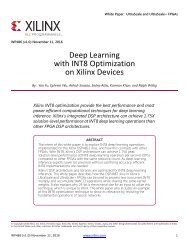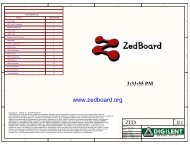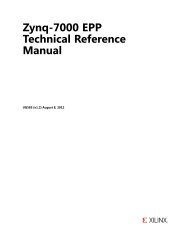UltraScale Architecture Memory Resources
ug573-ultrascale-memory-resources
ug573-ultrascale-memory-resources
You also want an ePaper? Increase the reach of your titles
YUMPU automatically turns print PDFs into web optimized ePapers that Google loves.
Chapter 1: Block RAM <strong>Resources</strong><br />
• A synchronous FIFO reset replacing the asynchronous reset in previous generations has<br />
been added.<br />
• FIFO latencies of the deassertion of the EMPTY/PROGEMPTY flag for a write operation<br />
and the FULL/PROGFULL flag for a read operation have changed.<br />
• The behavior of WRERR and RDERR during reset has changed.<br />
• FIFO asymmetric ports are now supported. The write port and read port can each be<br />
configured independently as x4, x9, x18, x36, or x72 for the FIFO36E2, and x4, x9, x18,<br />
or x36 for the FIFO18E2.<br />
• The combination of output operating modes (standard and first-word-fall-through) and<br />
output register stages configurations has changed.<br />
• WRCOUNT and RDCOUNT now support additional user-selectable functionality.<br />
• The block RAM ECC has additional pipeline registers for improved F MAX .<br />
• Hardware FIFOs are not backward compatible with 7 series FIFOs.<br />
Block RAM Introduction<br />
In addition to distributed RAM and high-speed SelectIO memory interfaces, <strong>UltraScale</strong><br />
architecture-based devices feature a large number of 36 Kb block RAMs. Each 36 Kb<br />
block RAM contains two independently controlled 18 Kb RAMs. Block RAMs are placed in<br />
columns within the clock regions (CRs) and across the device. The block RAM data output<br />
blocks are cascadable to enable a deeper memory implementation, have a sleep mode for<br />
power savings, and have selectable write mode operations.<br />
Synchronous Dual-Port and Single-Port RAMs<br />
Data Flow<br />
The true dual-port 36 Kb block RAM dual-port memories consist of a 36 Kb storage area<br />
and two completely independent access ports, A and B. Similarly, each 18 Kb block RAM<br />
dual-port memory consists of an 18 Kb storage area and two completely independent<br />
access ports, A and B. The structure is fully symmetrical, and both ports are<br />
interchangeable. Figure 1-1 illustrates the true dual-port data flow of a RAMB36. Table 1-2<br />
lists the port functions and descriptions.<br />
Data can be written to either or both ports and can be read from either or both ports. Each<br />
write operation is synchronous, and each port has its own address, data in, data out, clock,<br />
clock enable, and write enable. The read and write operations are synchronous and require<br />
a clock edge.<br />
<strong>UltraScale</strong> <strong>Architecture</strong> <strong>Memory</strong> <strong>Resources</strong> www.xilinx.com<br />
Send Feedback<br />
9<br />
UG573 (v1.2) February 24, 2015











